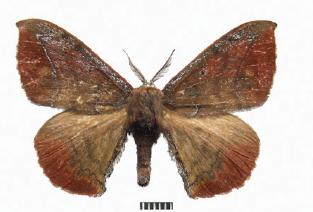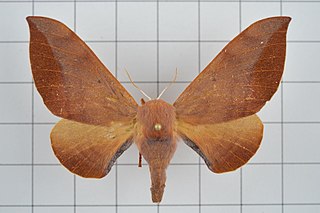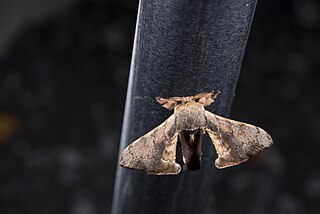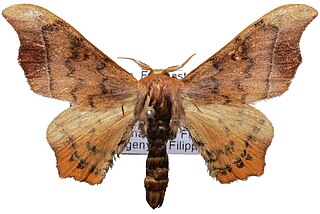
Bombyx mandarina, the wild silk moth, is a species of moth in the family Bombycidae. It is the closest relative of Bombyx mori, the domesticated silk moth. The silkworm is the larva or caterpillar of a silk moth. Unlike the domesticated relative which is unable to fly or indeed persist outside human care, the wild silk moth is a fairly ordinary lepidopteran. Its main difference from the domesticated taxon is the more slender body with well-developed wings in males, and the dull greyish-brown colour.

Apatelodidae, the American silkworm moths, is a family of insects in the order Lepidoptera. They are a family within the superfamily Bombycoidea, though they have in the past been considered a subfamily of Bombycidae.

Andraca bipunctata is a moth of the family Endromidae. It is found in China (Yunnan), India, Bhutan, northern Thailand, Myanmar and Nepal. The larvae are referred to as bunch caterpillars.

Oberthueria is a genus of moths of the Endromidae family. The genus was previously placed in the subfamily Oberthueriinae of the Bombycidae family.

Bombyx huttoni, or the chocolate-tipped silk moth, is a moth belonging to the silk moth family, Bombycidae. It is closely related to the domestic silk moth.

Mustilia fusca is a species of moth in the family Endromidae first described by Yasunori Kishida in 1993. It is found in Taiwan.
Mustilia falcipennis is a moth in the family Endromidae first described by Francis Walker in 1865. It is found in India and Bhutan.

Mustilia sphingiformis is a moth in the family Endromidae first described by Frederic Moore in 1879. It is found in south-east Asia, including Vietnam, Myanmar, India and Bhutan.

Prismosticta fenestrata is a moth in the family Endromidae first described by Arthur Gardiner Butler in 1880. It is found in China, Taiwan, India and Nepal.

Oberthueria formosibia is a moth in the Endromidae family. It is found in Taiwan.

Trilocha varians, the Greenish silk-moth is a moth in the family Bombycidae described by Francis Walker in 1855. It is widespread in the Oriental region from India, Sri Lanka, China, extending to Taiwan, the Philippines, Pakistan, Sulawesi and Java.

Oberthueria caeca is a moth in the Endromidae family. It was described by Oberthür in 1880. It is found in China, Korea and the Russian Far East. The habitat consists of lowland broad-leaved humid forests.
Oberthueria yandu is a moth in the Endromidae family. It is found in China.
Oberthueria jiatongae is a moth in the Endromidae family. It is found in China.
Oberthueria lunwan is a moth in the Endromidae family. It is found in China (Yunnan) and north-eastern Myanmar.









